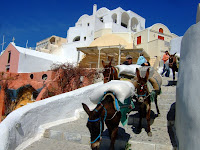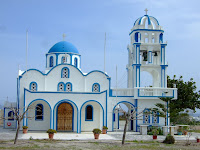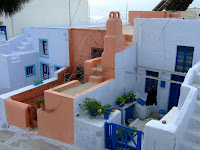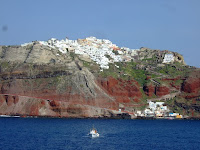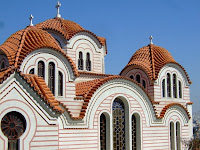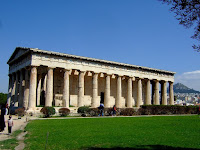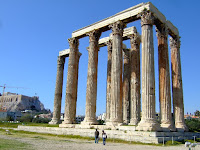"Paul left Athens and went to Corinth" 
(Acts 18:1) and, since the next most popular day trip from Athens is to Corinth, we decided to follow Paul's example. The buses to Corinth leave from Terminal A and the local bus to Terminal A went right past our Hotel. All in all it seemed a promising start. We left the Hotel and walked to the corner where the bus stop was, stopping at the street kiosk to buy a bus ticket. "Sorry, no ticket." A quick jog back to the Hotel to check where we could purchase a bus ticket, only to be pointed back to the kiosk I had just left. No matter, there were plenty more kiosks in the locality. Sorry-no-ticket-kiosk four suggested I try the Metro station but the door to the Metro was closed. Optimistically, I crossed the road to the other Metro entrance, also barred: this was getting serious. Finally I managed to encourage a lady in a mini-market to leave her conversation and return to her counter and sell me the needed bus tickets.

Arriving at Terminal A we located the counter which sold tickets to Corinth (they seem to have one ticket selling counter and agent per destination) and noted that the next bus was scheduled to leave in 10 minutes. No particular problem there except that the agent was on the phone to his broker/wife/mistress/bookie/whatever and was not going to interrupt his important call for a couple of tourists. As the time ticked past 4 minutes to go I began tapping on my watch meaningfully, but the phone call continued. This was particularly worrying, as yesterday's bus to Delphi had left 3 minutes before the scheduled time. Finally, right on the departure time the agent finished his call; put in a quick call to the controller on the platform; sold us the tickets; and told us we needed to hurry: something we had been trying to tell him for the past 10 minutes!

We collapsed into our seats for the journey to modern Corinth, crossing the Corinth Canal, cut over 90m into solid rock. First suggested in 6BC it was begun by Nero in 67AD and finished by French engineers 1826 years later.
Instead of taking us to the bus depot we were deposited in the centre of modern Corinth and directed to the place where the local bus to Ancient Corinth would depart. We spent a couple of unhurried hours browsing the ruins and museum and seeing the Bema, the place where Paul was brought by the Jewish elders who had their case dismissed by Galliio, the proconsul.
(Acts 18:12-17)

The local bus dropped us back in the centre of modern Corinth but it appeared that the bus back to Athens did not collect from there and we had to walk back to the bus station. Fortunately we had time before the next scheduled departure, but it did seem a very strange arrangement. As we approached Athens we were caught in a traffic jam and crawled along for some time, broken only by a slanging match between the passengers and driver. They were all quite voluble with their various opinions and it was a pity that it was all Greek to us: we did pick out the word 'Metro' a few times.
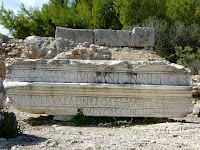
Finally, the passengers in the know started to assemble their coats and bags so we assumed we were nearly back to Terminal A, however the bus just pulled to the side of the road and the passengers started to disembark. Looking out the window I realised I was looking down the street to our Hotel so we quickly joined the exodus.
It transpired that the Metro was on strike and had been all day, hence the shut doors this morning and the chaos on the roads. But worse was to come.
As we had an early start scheduled for our ferry to Santorini the next morning we thought we should check out the travel options and when we did we found that Wednesday was to be a general strike: so, no buses, no Metro, no archaeological sites, no tourist information office - nothing. Returning to the Hotel we attempted to organise a taxi for the morning, only to be told that it was not the way things were done - simply ring in the morning and hope!
That, however, is not our way, so we wandered out to the main street nearby and arranged with a friendly taxi driver to collect us at 6 a.m. in the morning. We shall discover if he is as good as his word.

Later that evening the general strike struck again. The electricity was turned off for 90 minutes, just as we were beginning to pack our bags for our early morning start. Fortunately the laptop had a full charge and there was enough illumination from the screen to see what we were doing, although we did abandon packing and used the light to get ourselves to bed, instead.
Because of our early start the next morning we had returned to the hotel reasonably early. We had taken the guidebook advice and dined in view of the floodlit Acropolis so it was fortunate that we had made it back to the hotel before the lights went out as finding our way back in a darkened and unfamiliar city may have been a challenge, especially given the piles of fetid garbage spilling out all over the streets because of non-collection due to the strike.
Many more photos here

 We had not been to the O2 Dome (ex Millennium Dome) in all the time we have been in London so when the Tuthankamun exhibition was staged there we thought it would be an excellent way to round off our Egyptian odyssey and see the Dome in one visit.
We had not been to the O2 Dome (ex Millennium Dome) in all the time we have been in London so when the Tuthankamun exhibition was staged there we thought it would be an excellent way to round off our Egyptian odyssey and see the Dome in one visit. The Tutakhamun exhibition, while well done was a little short on the “good stuff” that one associates with the name and thus was over priced for what little there was on display. Fortunately we had seen the real treasures in the Cairo Museum in December 2003.
The Tutakhamun exhibition, while well done was a little short on the “good stuff” that one associates with the name and thus was over priced for what little there was on display. Fortunately we had seen the real treasures in the Cairo Museum in December 2003. A couple of tube stops away, after crossing under the Thames twice but remaining on the south bank, is Canada Water and the area called Rotherhithe. Like most of the old dock areas, the warehouses have been turned into apartments; the locks and quays tidied up; and the area regenerated.
A couple of tube stops away, after crossing under the Thames twice but remaining on the south bank, is Canada Water and the area called Rotherhithe. Like most of the old dock areas, the warehouses have been turned into apartments; the locks and quays tidied up; and the area regenerated. The Pilgrim Fathers seem to have sailed to the New World from Boston, from Plymouth, from Southampton and also from a pub called the Mayflower that we walked past today on the Thames. The truth is out there somewhere.
The Pilgrim Fathers seem to have sailed to the New World from Boston, from Plymouth, from Southampton and also from a pub called the Mayflower that we walked past today on the Thames. The truth is out there somewhere.










